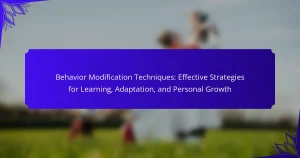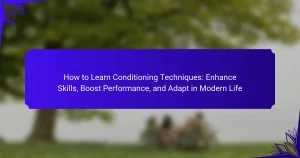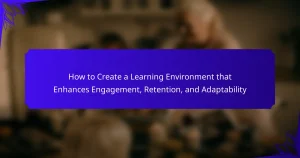Enhancing student engagement, retention, and motivation is crucial in modern classrooms. Behavioral learning focuses on observable behaviors through reinforcement techniques. This article explores strategies like positive reinforcement, structured feedback, and gamification. It also addresses assessment methods for measuring effectiveness and common pitfalls to avoid in implementing these techniques.
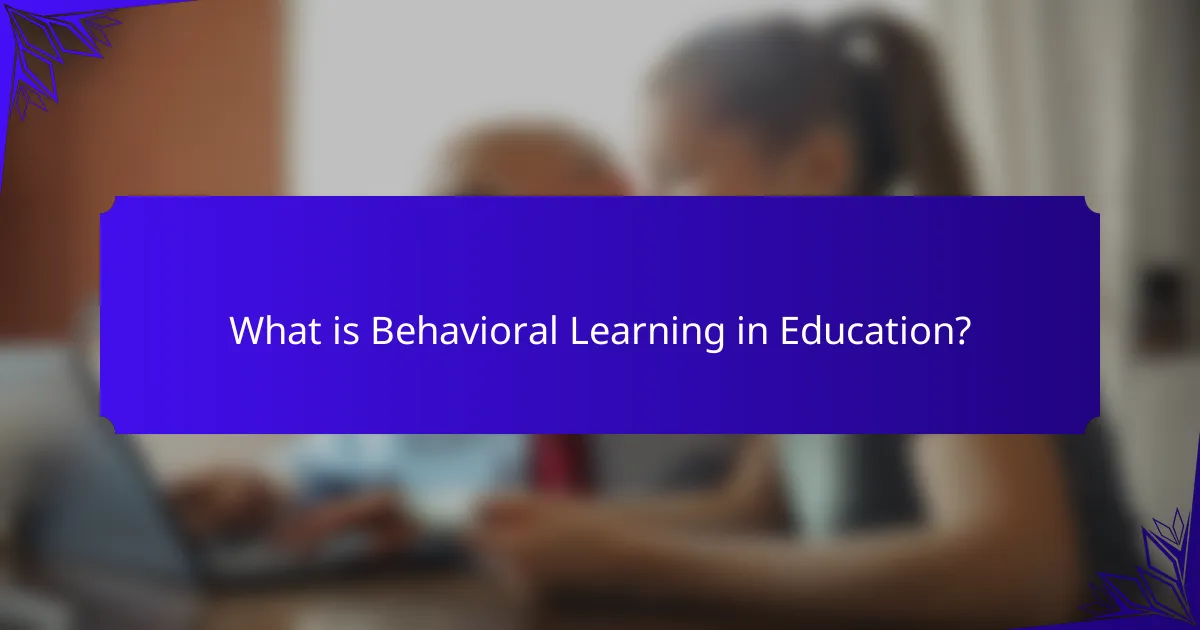
What is Behavioral Learning in Education?
Behavioral learning in education focuses on enhancing student engagement, retention, and motivation through observable behaviors. This approach utilises reinforcement strategies to shape learning experiences, making them more effective. For example, positive reinforcement encourages participation, while consistent feedback helps students track their progress. By implementing these techniques, educators can create an environment that fosters active learning and personal growth. Research indicates that behavioral learning strategies can significantly improve academic outcomes, making them essential in modern classrooms.
How does it differ from traditional learning theories?
Behavioral learning differs from traditional learning theories by emphasising observable behaviors and external stimuli rather than internal cognitive processes. Traditional theories, like constructivism, focus on understanding mental models and knowledge construction. In contrast, behavioral learning prioritises reinforcement and feedback to shape student engagement and motivation. This approach is particularly effective in modern classrooms, where technology and structured environments can enhance retention through consistent behavioral reinforcement.
What are the key principles of behavioral learning?
The key principles of behavioral learning include reinforcement, conditioning, and observable behavior modification. Reinforcement encourages desired behaviors through rewards or consequences. Conditioning, both classical and operant, establishes associations between stimuli and responses. Observable behavior modification focuses on measurable changes in behavior rather than internal processes, emphasising the importance of external stimuli in learning environments. These principles enhance engagement, retention, and motivation in modern classrooms.
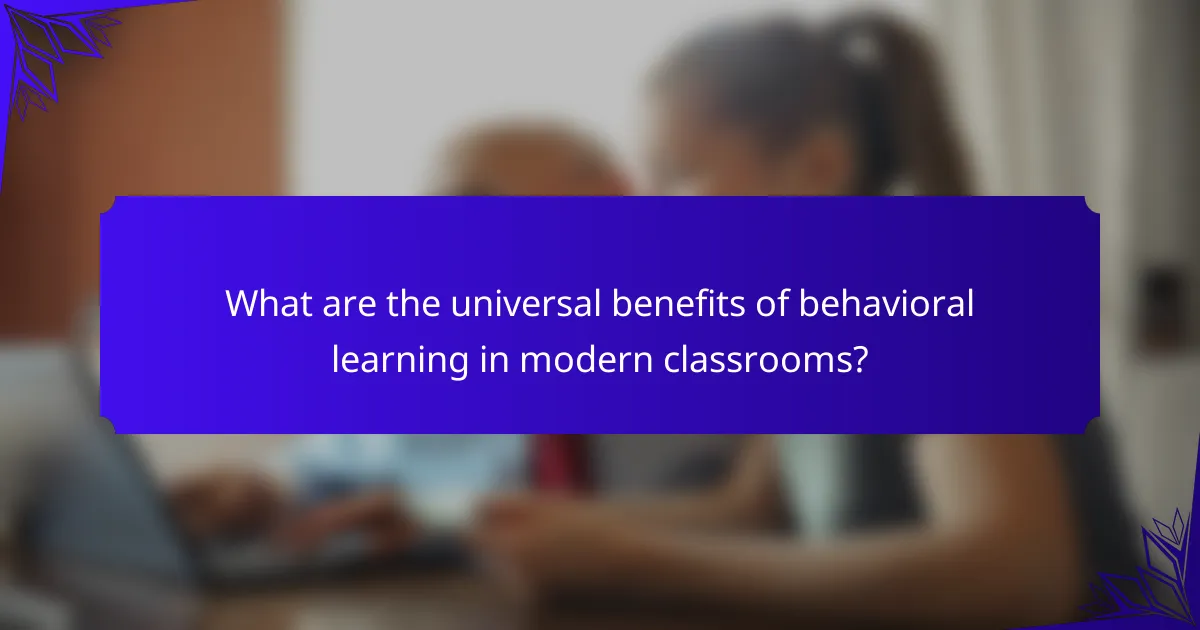
What are the universal benefits of behavioral learning in modern classrooms?
Behavioral learning in modern classrooms enhances engagement, retention, and motivation. This approach fosters active participation through structured feedback and reinforcement techniques. Students experience improved academic performance as they receive immediate responses to their actions, which builds confidence and encourages persistence. Additionally, behavioral learning promotes a positive classroom environment, reducing distractions and increasing focus. By integrating these strategies, educators can effectively address diverse learning needs, ensuring all students benefit from a supportive and dynamic educational experience.
How does it enhance student engagement?
Behavioral learning enhances student engagement by promoting active participation and personalised learning experiences. It encourages students to interact with the material through practical applications and collaborative activities. As a result, students are more likely to retain information and remain motivated. Studies indicate that classrooms utilising behavioral learning strategies see a significant increase in student participation rates, which fosters a more dynamic learning environment.
What role does it play in improving retention rates?
Behavioral learning significantly enhances retention rates by fostering active engagement and motivation in students. This approach emphasises reinforcement and feedback, which are crucial for solidifying knowledge. Research indicates that students who participate in behaviourally-based activities retain information more effectively, leading to improved academic performance. For example, incorporating gamification elements can increase student motivation and lead to a 30% rise in retention rates compared to traditional methods.
How can it boost motivation among students?
Behavioral learning can significantly boost motivation among students by fostering a sense of achievement and engagement. This approach emphasises positive reinforcement, which encourages students to participate actively in their learning process. For instance, rewards for completing tasks can enhance intrinsic motivation, leading to better retention of knowledge. Additionally, collaborative learning environments promote social interaction, further motivating students to engage with their peers. Research shows that students who experience behavioral learning strategies exhibit higher levels of motivation and commitment to their studies.
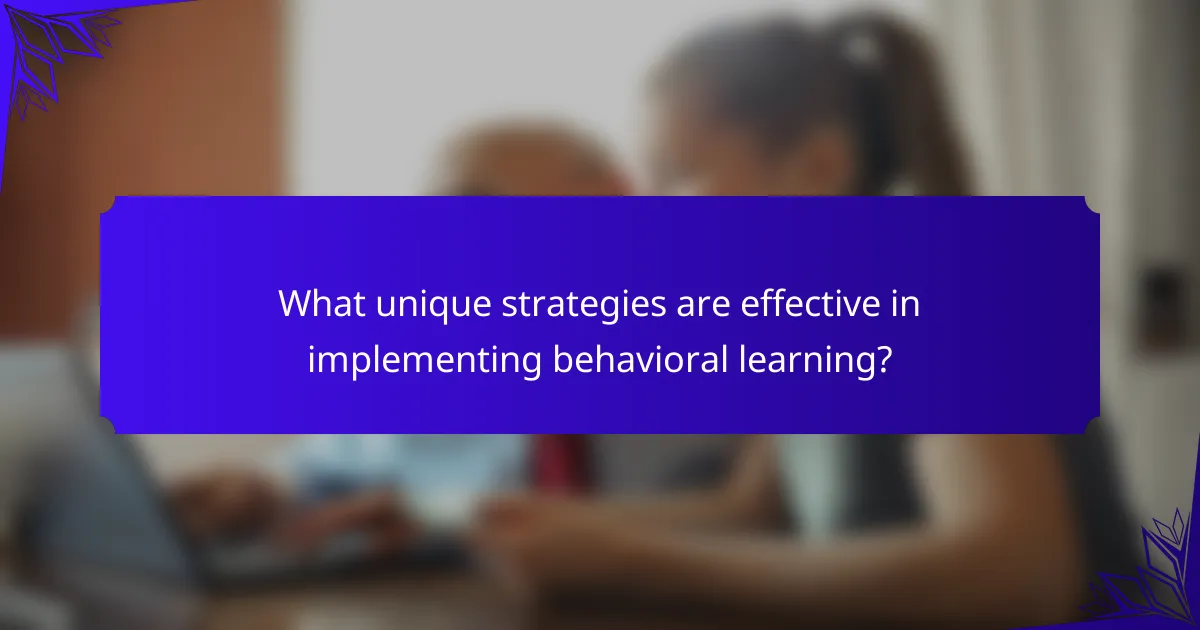
What unique strategies are effective in implementing behavioral learning?
Effective strategies for implementing behavioral learning include positive reinforcement, structured feedback, and goal-setting. Positive reinforcement encourages desired behaviors, enhancing student motivation. Structured feedback provides clear guidance, helping learners understand their progress. Goal-setting fosters accountability and focus, driving engagement in educational activities. These strategies create a supportive learning environment that promotes retention and motivation.
How can positive reinforcement be applied in the classroom?
Positive reinforcement can be effectively applied in the classroom by recognising and rewarding desired behaviors. This approach enhances student engagement and motivation. Teachers can implement strategies such as verbal praise, tangible rewards, or privileges to reinforce positive actions. As a result, students are more likely to repeat these behaviors, leading to improved retention of information and a more conducive learning environment.
What are effective methods for providing feedback?
Effective methods for providing feedback include specific, timely, and constructive comments. These approaches enhance student engagement and motivation in behavioral learning contexts. Regular feedback fosters a growth mindset, encouraging students to view challenges as opportunities for improvement. Incorporating peer feedback sessions can also deepen understanding and retention by allowing students to learn from one another.
What role do structured environments play?
Structured environments significantly enhance behavioral learning by providing predictable routines and clear expectations. These settings foster engagement, as students feel more secure and focused. Additionally, structured environments improve retention by reinforcing learning through consistent reinforcement techniques. Motivation increases when students experience success within these frameworks, leading to a positive feedback loop that encourages further participation. Overall, structured environments are essential in modern classrooms for optimising educational outcomes.
How can classroom management techniques support behavioral learning?
Classroom management techniques enhance behavioral learning by creating structured environments that promote engagement and motivation. Effective strategies include clear expectations, consistent routines, and positive reinforcement. These methods support students in understanding behavioral norms, leading to improved retention of information and skills. For instance, incorporating group activities fosters collaboration and accountability, enhancing the learning experience. Research indicates that classrooms with strong management techniques see higher student participation and lower behavioral issues, ultimately supporting academic success.
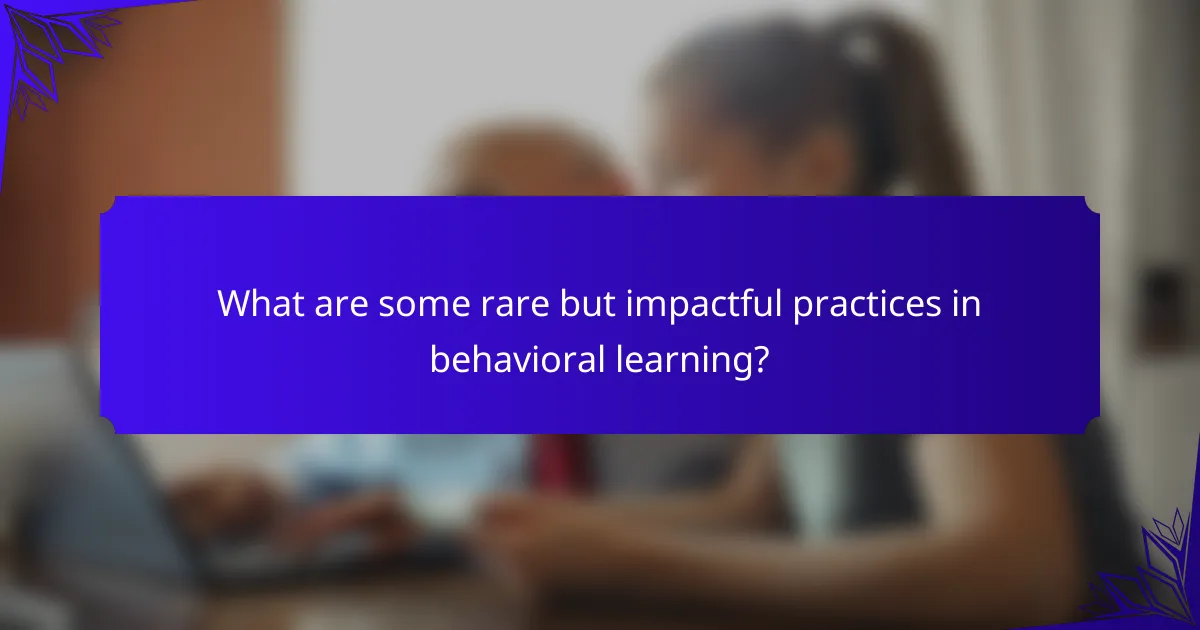
What are some rare but impactful practices in behavioral learning?
Rare but impactful practices in behavioral learning include gamification, mindfulness techniques, collaborative learning, and experiential learning. These strategies enhance student engagement and motivation significantly.
Gamification integrates game mechanics into lessons, fostering competition and achievement. Mindfulness techniques improve focus and emotional regulation, leading to better retention. Collaborative learning promotes peer interaction, enhancing critical thinking skills. Experiential learning allows students to apply knowledge in real-world contexts, deepening understanding.
How can gamification enhance learning experiences?
Gamification enhances learning experiences by increasing engagement, retention, and motivation among students. It incorporates game elements into educational settings, making learning interactive and enjoyable. This approach fosters a sense of achievement through rewards and challenges, leading to improved performance. Research indicates that gamified environments can boost student participation by up to 60%, enhancing overall educational outcomes. By leveraging competition and collaboration, gamification creates a dynamic atmosphere that encourages continuous learning and skill development.
What innovative technologies are being used to support behavioral learning?
Innovative technologies supporting behavioral learning include adaptive learning platforms, gamification tools, and virtual reality environments. These technologies enhance student engagement, improve retention, and boost motivation by personalising learning experiences. Adaptive learning platforms tailor content to individual student needs, while gamification incorporates game elements to make learning enjoyable. Virtual reality provides immersive experiences, allowing students to explore concepts in a hands-on manner. These advancements foster a more effective learning environment in modern classrooms.
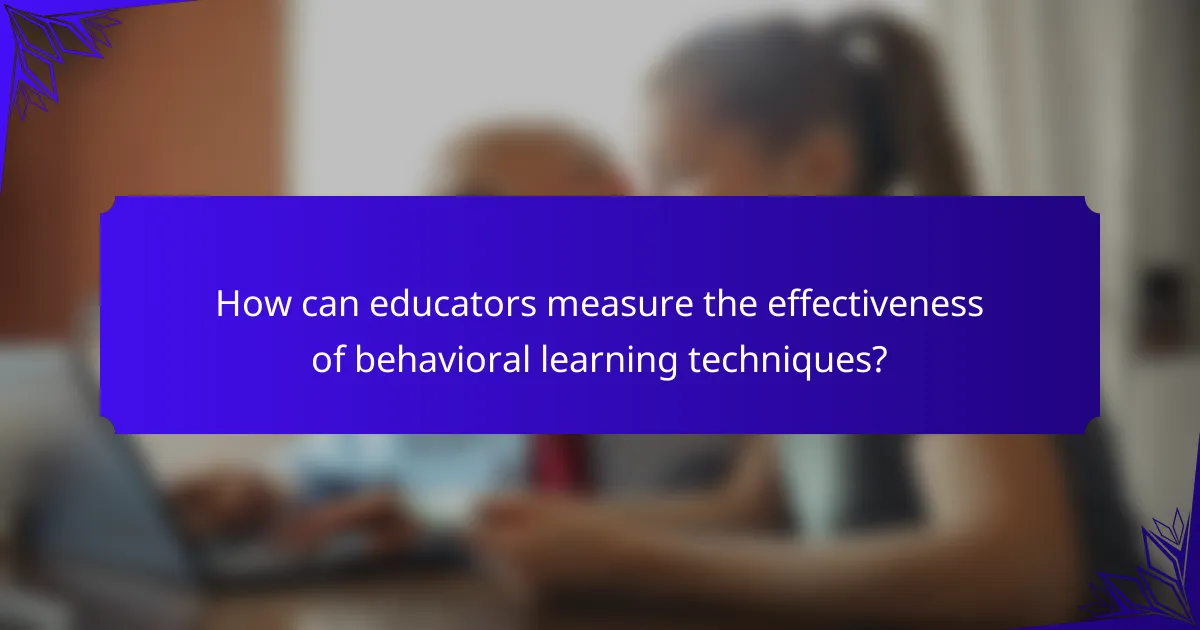
How can educators measure the effectiveness of behavioral learning techniques?
Educators can measure the effectiveness of behavioral learning techniques through various assessment methods. These include tracking student engagement, monitoring retention rates, and evaluating motivation levels.
Engagement can be assessed using participation metrics, such as attendance and active involvement in classroom activities. Retention rates indicate how well students remember and apply learned concepts over time. Motivation can be gauged through surveys and feedback mechanisms that assess students’ interest and enthusiasm for learning.
Furthermore, educators can implement formative assessments to provide ongoing feedback, allowing for adjustments to teaching strategies. By analysing these metrics, educators can refine their approaches and enhance the overall learning experience.
What assessment tools are available for tracking student progress?
Various assessment tools are available for tracking student progress in behavioral learning. These tools include formative assessments, summative assessments, observational tools, and digital platforms.
Formative assessments, such as quizzes and class discussions, provide immediate feedback on student understanding. Summative assessments, like standardised tests, evaluate cumulative knowledge at the end of a learning period. Observational tools allow teachers to monitor student engagement and behavior in real-time. Digital platforms, such as learning management systems, offer analytics to track progress over time, enhancing engagement and motivation.
Each tool serves to create a comprehensive view of student performance, aiding in tailored instructional strategies.
How can educators adapt their approaches based on assessment outcomes?
Educators can adapt their approaches by analysing assessment outcomes to tailor instruction. This involves identifying student strengths and weaknesses, adjusting teaching strategies, and providing targeted support. For instance, differentiated instruction can enhance engagement by catering to diverse learning styles. Additionally, formative assessments enable real-time feedback, allowing educators to modify lessons promptly. Emphasising collaborative learning can further boost retention and motivation, creating a dynamic classroom environment.
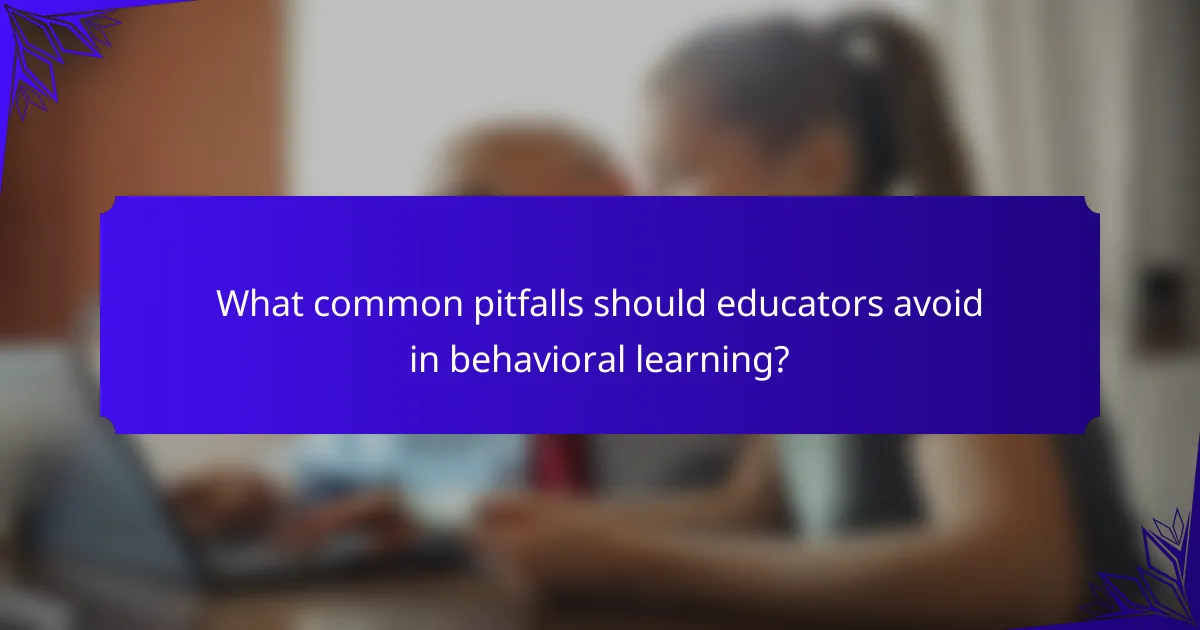
What common pitfalls should educators avoid in behavioral learning?
Educators should avoid common pitfalls such as neglecting individual learning styles, over-reliance on extrinsic rewards, and failing to provide timely feedback. These mistakes can hinder student engagement and motivation. Understanding these challenges is crucial for effective behavioral learning. Additionally, not fostering a positive classroom environment can lead to decreased retention and participation.
What are the risks of over-reliance on rewards?
Over-reliance on rewards can lead to diminished intrinsic motivation. Students may focus solely on external incentives rather than engaging with the learning material itself. This shift can result in reduced creativity and critical thinking. Furthermore, dependency on rewards may create anxiety about performance, hindering overall learning outcomes.
How can misunderstanding behavioral principles hinder student development?
Misunderstanding behavioral principles can significantly hinder student development by impeding engagement and motivation. When educators misapply these principles, they may fail to create effective reinforcement strategies, leading to decreased student interest. For instance, inconsistent feedback can confuse students, reducing their ability to retain information. Additionally, overlooking the importance of intrinsic motivation can result in a reliance on extrinsic rewards, which may not foster long-term learning. Ultimately, a lack of understanding of behavioral principles can create an environment that stifles growth and achievement.
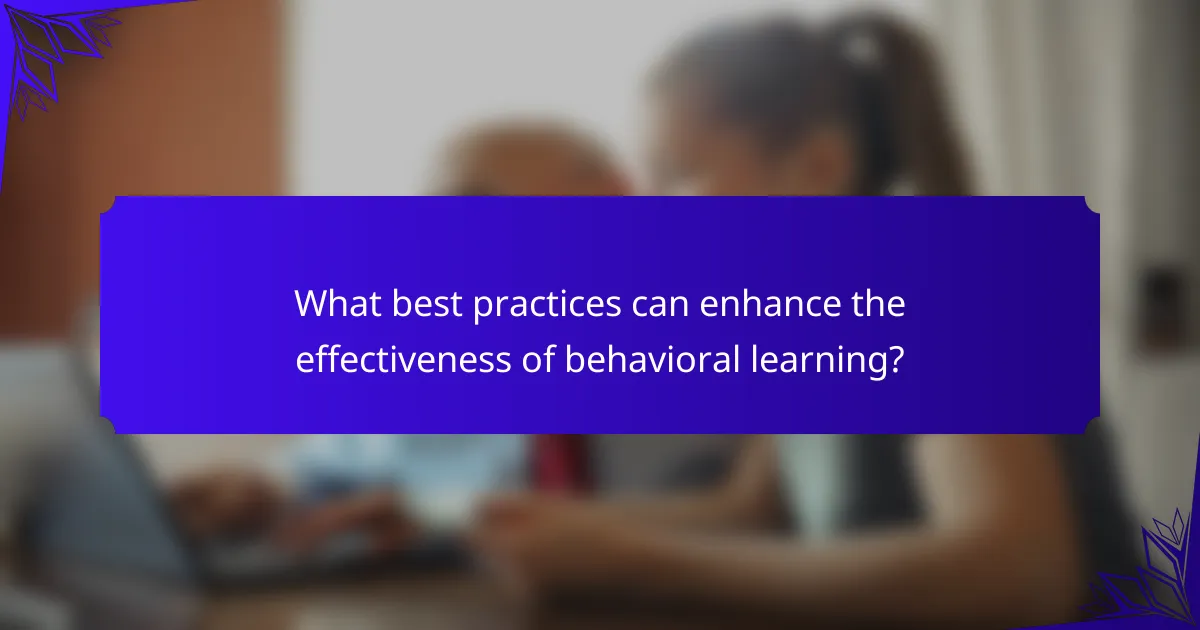
What best practices can enhance the effectiveness of behavioral learning?
To enhance the effectiveness of behavioral learning, educators should implement active engagement strategies, provide immediate feedback, utilise reinforcement techniques, and create a supportive learning environment. Active engagement keeps students involved, while immediate feedback helps them correct mistakes promptly. Reinforcement techniques, such as praise or rewards, motivate learners and encourage positive behaviors. A supportive environment fosters trust, allowing students to take risks in their learning.
How can educators create a balanced approach to behavioral learning?
Educators can create a balanced approach to behavioral learning by integrating structured reinforcement strategies with student-centred practices. This combination enhances engagement and motivation while fostering a supportive learning environment.
Implementing clear behavioral expectations is essential. Educators should establish rules and consequences that are consistently applied, promoting a sense of fairness. Additionally, incorporating positive reinforcement encourages desired behaviors, enhancing student retention of concepts.
Another key aspect is the use of varied instructional methods. Blending direct instruction with collaborative learning opportunities caters to diverse learning styles, increasing student participation. For example, group activities can reinforce social skills alongside academic content.
Finally, ongoing assessment and feedback are critical. Regularly evaluating student progress allows educators to adjust strategies effectively, ensuring that behavioral learning remains aligned with educational goals. This responsive approach supports sustained motivation and engagement in the classroom.
What professional development opportunities are available for teachers?
Professional development opportunities for teachers include workshops, online courses, mentorship programs, and conferences. These options enhance skills in behavioral learning, fostering engagement and motivation. Workshops often focus on specific strategies, while online courses provide flexibility in learning. Mentorship programs pair experienced educators with novices, promoting knowledge sharing. Conferences offer networking and exposure to innovative practices. Each opportunity contributes uniquely to teacher effectiveness and student outcomes.
